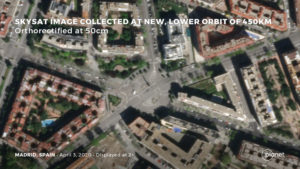SAN FRANCISCO – Planet unveiled API and a cloud-based dash to allow clients to work the firm SkySat constellation.
It was the most recent step in Planet’s campaign. Within the previous six months, the company bought rides to expand the constellation and improve rates and has reduced the elevation of 15 SkySats in orbit to improve resolution.
All of the changes are made to provide government and business clients simple access to high-resolution imagery of places at several times throughout the day and”a much better sense of activity on earth,” Jim Thomason, Planet vice president of imagery products, informed SpaceNews.
Planet created”a new user interface that allows customers to work SkySat imagery in an efficient, automated way” because clients expressed”a desire to have simpler and faster workflows,” the firm stated in a June 9 website post. “Instead of spending valuable time going back and forth using an individual [agent ], together with the tasking dash and API, clients can autonomously submit, modify and cancel SkySat imagery requests. This permits visibility into the final experience, to be able to satisfaction, so expectations may be managed with teams and analysts .”Planet is well-known for capturing daily imagery of the landmass of Earth using its Dove cubesat constellation. Many of Planet’s recent statements have focused on the SkySat constellation that the San Francisco firm acquired by Google in 2017.
SkySats were created to provide imagery. In response Earth reduced SkySat altitudes instead of redesigning satellites.
By lowering SkySats from an altitude of 500 km Planet enhanced the resolution of imagery from 80 centimeters to 50 centimeters per pixel.
“This advancement enables customers to find a more exact view of changing conditions on the ground and adds more granular context to decision-making,” Earth said at the website. “This is very crucial for government and commercial mapping application cases, where seeing smaller features like road surface markings are crucial.”
Mike Safyan, Planet vice president of launch, said that the unconventional decision to reduce SkySats originated from”a casual conversation in a meeting.” After the assembly, Planet engineers evaluated the effect propellant budgets, on satellite resides and whether the transfer could be made without disrupting customer service.
“We don’t completely throw the aerospace textbook from the window, but we wonder a whole lot of accepted standards and practices to determine if there are ways we can push the limits,” Safyan informed SpaceNews.
Planet is preparing to expand the SkySat constellation using three SkySats scheduled to launch 9 rocket along with Starlink broadband tanks. Three additional SkySats are thought to share the journey to orbit about a month. The six new SkySats are destined to get orbits of 53 degrees.
With 21 SkySats in sun-synchronous and mid-inclination orbits, Planet expects to provide clients a mean of seven chances to view places to attain imagery of sites near 53 degrees latitude, according to the June 9 website.
The June SkySat launching includes about six months after SpaceX Earth and Planet signed the launching contract. Safyan features the rate to the simple fact that Planet has flown SpaceX before, delivering two SkySats to a committed rideshare assignment in 2018.
“From dovetailing with their launching schedule, we mimicked the tanks, built a new rocket interface, designed a new reef program (because of the low orbit insertion of these distinctive launches) and delivered them to get launching, all within half a year,” based on the June 9 blog.
– Advertisement –
